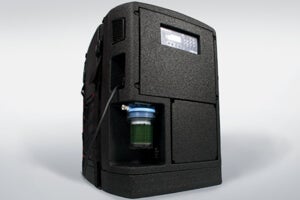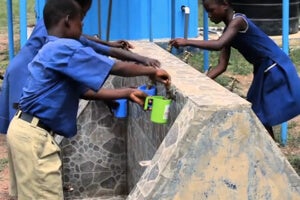Kamen and Coca-Cola Take On World’s Clean Water Shortage With Slingshot Purifier
Singularity Hub chatted with Paul Lazarus about his award-winning short film "Slingshot" and the film's namesake invention. Lazarus told us about the agony of condensing a grand challenge and potential solution to three minutes—and what he thinks the future promises for both.

Share
Veteran filmmaker, Paul Lazarus, has long experience making mainstream television shows and documentaries. But he says his latest work "Slingshot"—a short film on Dean Kamen’s Slingshot water purification system—is “the first documentary I’ve ever been involved in where the work we’re doing has the capacity to impact the story itself.”
Voted on by the public, the film was recently named a top five jury prize winner in the Focus Forward Filmmaker competition and will vie for the contest’s $100,000 grand jury prize at the 2013 Sundance Film Festival. Proof that powerful creations can come in small packages. And of course, the same can be said of Slingshot.
What is Slingshot and how does it work? To quote the Grateful Dead (apologies), it’s just a box of rain. The water purification system takes contaminated water (virtually anything wet in fact—no source is too dirty), vapor distills it (like the sun), and cools the resulting “clouds” to recondense water pure as rain. All that for the energy-cost of a hair dryer.

Slingshot vapor distills contaminated water, cools the vapor, and re-condenses water pure as rain. Image Credit: Patrik Svensson
Water-borne pathogens cause roughly 50% of the world’s disease, and Kamen hopes Slingshot can put a big dent in that number. But it’s been no easy road from idea to execution. For over a decade, Kamen has been hard at work honing his design, making it more compact and more energy and cost efficient.
Now, the hard work seems to be paying off. Last September, Coca-Cola agreed to a long-term partnership with Kamen’s research firm, DEKA. Coca-Cola and DEKA are expanding last year's trials in Ghana to Paraguay, Mexico, South Africa, and hopefully beyond.
Singularity Hub chatted with Lazarus about "Slingshot" and the film's namesake invention. Lazarus described the agony of condensing a grand challenge and potential solution to three minutes—and what he thinks the future promises for both.
But first, the film.
SLINGSHOT | Paul Lazarus from Focus Forward Films on Vimeo.
How did you decide to work with Dean Kamen to make this film?
I’ve had a longstanding relationship with Dean. Known him for thirty years plus. In the mid-2000s, when he told me about the Slingshot device, I thought the potential impact of this invention would be mind-bogglingly large. The Slingshot could ultimately improve the lives of millions and millions of people across the planet.
I said to Dean, “You’re such a force in the world and you’re doing so much good. I’d really like somehow to document the process of how you attack one of the world’s grand challenges and tell that story. I think it will offer hope and inspiration, and, bottom line, it’s just a good story.”
There’s a saying about writing, “I would have made it shorter if I had the time.” Was it challenging "boiling" the story of the Slingshot down to three minutes?
That’s an understatement. The idea of expressing what is going on with the world’s clean water crisis, this piece of technology, Dean Kamen. You start adding those things in and three minutes is an impossibly short amount of time. You have to rely on your gut instinct of what is essential to get across. The curse of a three minute form is all the things you want to say and can’t even begin to address.
What would you have included if you'd only had one more minute?
That’s a really provocative and difficult question. There are so many things. If I could pick one thing in one minute, it would have been to talk more about how hard it is to get a good idea adopted by the world. Dean’s 15+ year struggle to take what is now, in hindsight, a fantastic idea and get it accepted. I had to skip over that struggle. Three minutes on some level conveys that it was all easy.
How does being a top five finalist in the Focus Forward Filmmaker competition impact awareness of the Slingshot and the problem it’s trying to solve?
This has been the first documentary I’ve ever been involved in where the work we’re doing has the capacity to impact the story itself. For example, you do trials of the technology in five remote schools in Ghana. Well, how does anybody know what that looks like? How do you know what the school looks like? How do you know what it means for kids not to have running water and then to get clean running water?
Be Part of the Future
Sign up to receive top stories about groundbreaking technologies and visionary thinkers from SingularityHub.


You can do it by an interview process. You can do it anecdotally. But if you have the imagery that shows how something was installed, what the life of the village looked like prior to the machine and after—you can very quickly convey the success of the technology.
So, when Dean Kamen is talking about seeing the images for the first time, seeing the kids getting water, he’s responding to the film you took?
He’s talking about the images we filmed and brought back to him. Because he saw them for the first time through our footage. What was interesting in the interview is he described the images as being exactly as he had imagined all these years.
I feel very proud to be involved like this because the impact of the imagery is wider than you can imagine. It’s shown to executives at Coca-Cola. They are responding to the same images Dean is. It’s used as part of the Clinton Global Initiative. It’s not just capturing the story, it’s helping promote the use of this amazing technology. That’s our goal. To help Dean get the machine distributed.
The Ghana trials in the video…they were last year? The year before?
That was last year. To be specific, the machines were installed around October and were in five schools in rural Ghana through March. It was a six month trial from the end of 2011 and into 2012.
What do you think the next few years look like for the Slingshot?

Slingshot. Image Credit: DEKA Research and Development
Well, it’s been announced that Coca-Cola will help spread the technology. More than 30 machines are being built. There’s a whole new model that doesn’t look anything like the machine we shot in Ghana. The new machine is half the volume and half the weight.
One of the lessons learned in the Ghana trials was that to distribute these things all over the world to remote corners, you have to be able to move them. They adopted this standard, as long as it’s no bigger than a Coke cooler—since they already deliver Coke coolers all over the place—it can be delivered. So Dean’s team, all these amazing engineers at DEKA, took on the challenge of reducing the weight, reducing the volume, making it easier to assemble—all the things they learned from the successful trials in Ghana.
The new machine isn’t being mass-produced yet, but it’s not being assembled one at a time by hand either. The cost curve is going down, which is the result you want. And they’re being disseminated to Paraguay and Mexico and South Africa. A whole new wave of trials will happen this year. And I would say, pending the success of those trials, hopefully more machines will be produced and the cost curve will go further down, and so on.
Any plans for more similarly themed films? What’s next?
The best answer I can give you is we are hard at work on the long form version. This is just a three minute piece we did for the contest to try and get some attention and frankly help us make the movie a viable entity. But I’m hoping we make a 90 minute movie that’s seen by millions of people.
Thanks for your time and congratulations on being a top five jury prize winner in the Focus Forward Filmmaker competition—best of luck at Sundance!
Jason is editorial director at SingularityHub. He researched and wrote about finance and economics before moving on to science and technology. He's curious about pretty much everything, but especially loves learning about and sharing big ideas and advances in artificial intelligence, computing, robotics, biotech, neuroscience, and space.
Related Articles

Single Injection Transforms the Immune System Into a Cancer-Killing Machine

This Light-Powered AI Chip Is 100x Faster Than a Top Nvidia GPU

This Week’s Awesome Tech Stories From Around the Web (Through December 20)
What we’re reading


